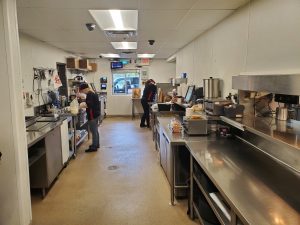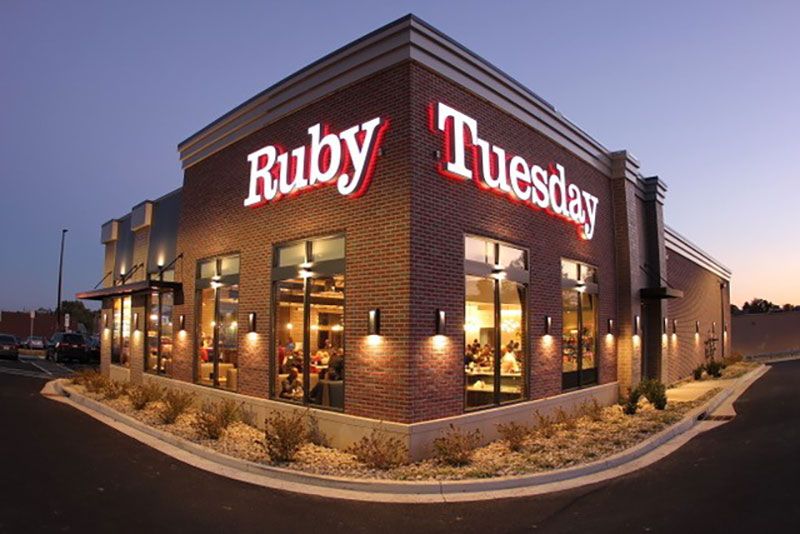Don’t call it a ghost kitchen and certainly don’t call it a virtual restaurant: The parent company of Ruby Tuesday has launched a new initiative called Franklin Junction that introduces a new delivery-focused model that it calls “host kitchens.” At its core, the plan is relatively simple. It allows outside restaurant brands to use the excess kitchen capacity at existing casual restaurants across the country strictly for delivery and as a low-cost option for brands looking to enter new markets.
If all goes according to designs laid out by Ruby Tuesday’s owner, Atlanta-based NRD Capital, in-restaurant diners will have no idea their restaurant is covertly cooking, packaging and delivering food from as many as four additional concepts all from the same kitchen.
Noting that the fund’s acquisition of Ruby Tuesday back in 2017 was a “head-scratcher” for many industry watchers, NRD Capital’s founder and Managing Partner Aziz Hashim said buying the brand as an asset-optimization play has been part of the plans from day one.

NRD Capital Founder – Aziz Hashim
“Our view has been that the restaurant industry has been over capacity for a while,” said Hashim, adding his belief that the industry could be over-built by as much as 20 percent. “The trick was, if you bought this asset at a relative discount on replacement value but you don’t have a plan for this asset on how you’re going to make it more efficient, then you probably shouldn’t have done it. But if you do have a plan of what you can do with this additional capacity, then it becomes a little more interesting.”
With so many of Ruby Tuesday’s nearly 500 locations occupying prime real estate, especially those on mall exteriors, Hashim said bringing additional concepts into the kitchens could be a game-changer, both for the host restaurant’s unit-level economics, as well as growth-oriented brands looking for less expensive ways to enter new markets.
Hashim said ghost kitchens are another interesting idea, but taken as a whole, they don’t solve the overcapacity issue, and they actually add to the problem. The exact definition of a virtual kitchen varies depending on the source, but he said his new host kitchen model is unique because it doesn’t require a new facility to be built or rented out, and also doesn’t require any new employees or kitchen equipment, since most casual-format restaurants already have fully stocked kitchens that can cook a wide range of foods.
“A host kitchen is a fully functioning restaurant that has a day job, and this is totally incremental,” Hashim said. He compared the model to a combination of Airbnb and Match.com, or maybe even Uber which through the simple advancement of an app revolutionized urban transport. “A virtual restaurant still requires a facility to be rented or built, and it still requires a set of employees to be hired specifically for that venture.”
 The concept was test piloted by Frisch’s Big Boy, which NRD also owns, where a second brand was introduced and marketed for delivery sales. Encouraging results drove quick expansion to more than locations throughout the Upper Midwest.
The concept was test piloted by Frisch’s Big Boy, which NRD also owns, where a second brand was introduced and marketed for delivery sales. Encouraging results drove quick expansion to more than locations throughout the Upper Midwest.
Some in the off-premises side of the restaurant industry would certainly take exception with Hashim’s definition of a virtual kitchen and how that differs from a host kitchen. Nextbite, for example, lets existing restaurant operators pick from a menu of curated virtual brands that could be cooked and delivered from their kitchens. ClusterTruck offers another variation on this theme, with delivery-only meals sold through its own ghost kitchen facilities that offer a range of concepts that the brand both owns and operates itself.
Both differ from Franklin Junction’s plan in critical ways. The host kitchen model is based on the idea that potential operators coming into the host kitchen wouldn’t have to invest any capital, beyond food inventory. On the real estate side, having prime locations with easy access to road networks—like most malls have in spades—is the most important component to reach the number of nearby households to make the concept pencil out for incoming brands.
Another key differentiator is Franklin Junction offers prospective brands matchmaking and demographic market intelligence to determine what concepts are missing from respective markets, including follow-up after that initial opening.
So far, it has signed up nearly 30 brands, including Nathan’s Famous Hot Dogs. All of the concepts are being deployed across a network of approximately 550 host facilities on the platform. Hashim expects another 1,000 host facilities will join the Franklin Junction network by the end of 2020.
The company declined to offer specifics on what it would charge incoming brands for the service, but Hashim stressed that it is a “small fee” that will come on top of whatever the third-party delivery brands charge for delivery service, as well as any franchise or licensing royalties that may apply for the incoming concept.
“People see this as a very straightforward proposition, so it’s not been difficult to get brands—the difficult part is saying no to brands, because simplicity is really key,” Hashim said. “If a brand has a very good but somewhat complex product to produce, then we are not trying to add more complexity to our hosts.”
Franklin Junction’s leadership team expects the average casual-format host to have enough capacity to add somewhere between two and four new concepts. Hashim notes that could include two brands selling hot meals and two that require no cooking at all, whether that’s a frozen treat brand or a meal-kit producer.
A slimmed-down menu from the added-in concept is the key to avoid overwhelming kitchen staff and capacity. Hashim expects that some brands might only offer 10 percent of their total menu in a host kitchen setting.
At the low end, adding multiple new brands into an existing casual restaurant could conservatively add 10 to 20 percent in additional sales, which the company estimates could bring in an extra $60,000 into an existing restaurant. Asked for a best-case scenario, Hashim said it’s conceivable to add another $500,000 in additional sales, which “at a 40 percent flow-through” could mean a $200,000 bump in profits.
Looking ahead, after tweaking and testing the concept over the last two years, NRD Chief Operating Officer Susan Beth said all of their research suggests this concept will succeed, benefit existing restaurant operators in their system and, especially in smaller markets, bring new restaurant brands to an entirely new set of customers.
“We’ve pressure-tested this thing from every direction, and there’s not a loser in the equation when we get it right,” Beth added. “When we get it right—and we’re gonna get it right—this is going to be a win for everybody who participates around it, all the way to the consumer … and that’s part of the reason we hit the accelerator.”




